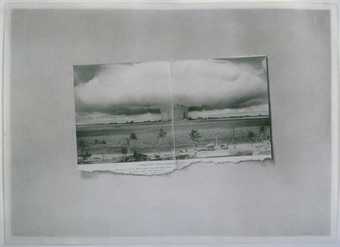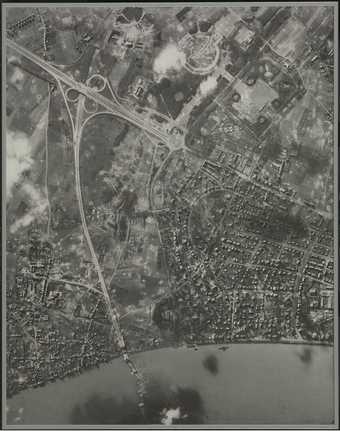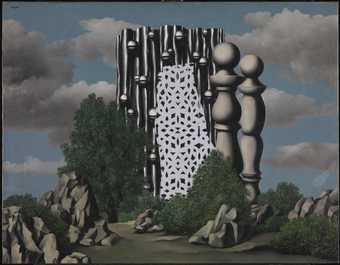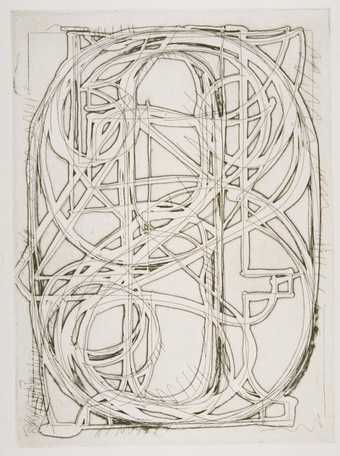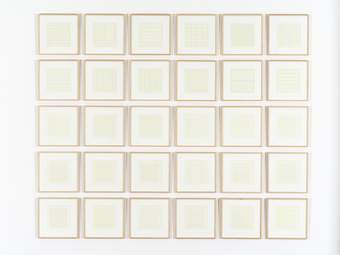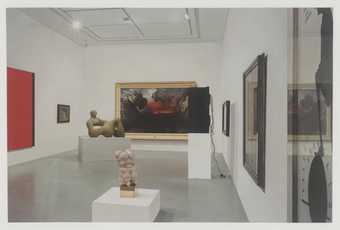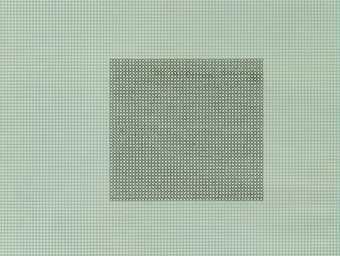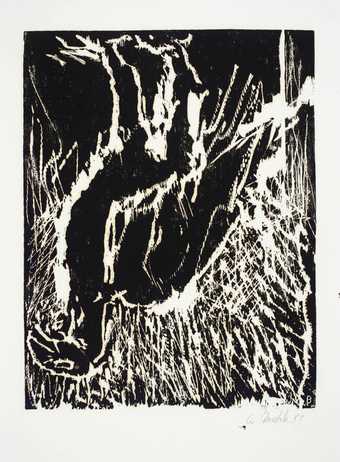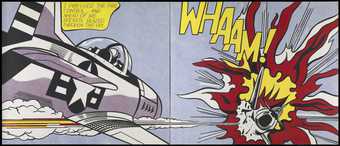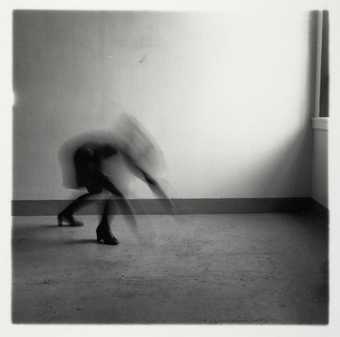
Vija Celmins
Ocean (1975)
Tate
Introduction
Vija Celmins is best known for her meticulous paintings and drawings of natural phenomena such as the ocean, spider webs, night skies, and deserts.
This resource takes a thematic look at her art and ideas through key works in the ARTIST ROOMS collection.
Meet the artist
In this video, Celmins allows us a rare glimpse into her studio providing a fascinating insight into her inspiration and processes.
Found images

Vija Celmins
Concentric Bearings A (1984)
ARTIST ROOMS Tate and National Galleries of Scotland
I’m not a very confessional artist, you know. I don’t ever reveal what I’m feeling in my work, or what I think about the President. I use nature. I use found images.
Vija Celmins
Vija Celmins was fascinated by images from an early age. As a young girl she moved with her parents from Latvia to Indianapolis in the USA and began collecting pictures from comic books and picture playing cards. ‘I had stacks of comics because I had sort of taught myself how to read, because I couldn’t speak English. I only spoke Latvian, really.’
Her interest in images continued, and in the 1960s Celmins began using photographs she found in magazines and books as a source for her art. Around this time she was also making sculpture based on everyday functional objects. Other artists in the 1960s such as Andy Warhol and Richard Hamilton were also making paintings and prints of found objects and images. These artists – known as pop artists – were using these sources to comment on popular culture and the brash consumerism of the day. Although Celmins’s work from this period is often discussed in relation to pop art, her ideas had more in common with the object paintings of artists such as René Magritte and Giorgio Morandi. She was inspired by their experimentation with object size and scale, and their depiction of objects detached from their original function.
Celmins's early object paintings, alongside her interest in scientific imagery, led to her making drawings and prints of seas, night skies and deserts. The first drawings she made using this type of imagery were based on photographs of planets and the surface of the moon. The late 1960s saw the culmination of the great ‘space race’ between the Soviet Union and the USA. On 20 July 1969 the spaceflight Apollo 11 landed on the moon and the media was full of dramatic images of outer space. Ceelmins was inspired by these images and began to use them in her work.
What do you think? Found images
The photograph is an alternate subject, another layer that creates distance. And distance creates an opportunity to view the work more slowly and to explore your relationship to it. I treat the photograph as an object, to scan and re-make in my art.
Vija Celimins
Look at Vija Celmins’s drawings and prints made from found photographs of natural phenomena.
- How do they look different from a photograph?
- Do you think people look at and respond to drawings or prints in a different way than they do documentary photographs?
Have a go: Using readymades
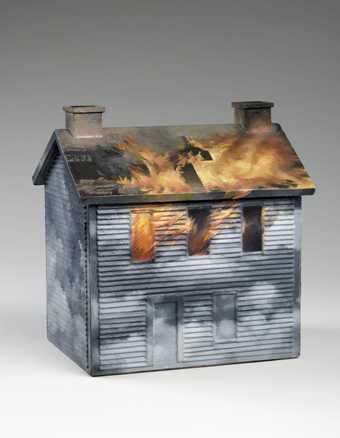
Vija Celmins House #2 1965
© Vija Celmins
Choose an image of an everyday object from a magazine or book.
Does the object have any significance for you? Do you feel that this matters?
Make a drawing of the object. Think of ways that you could alter how the object appears and make it have a different feel to how it looks in the photograph.
Top tips: Try selecting a detail of the object or changing its size. Use a range of different materials and styles or techniques to rework the image. If the image is in colour, redo it in black and white.
The natural world

Vija Celmins
Ocean Surface Woodcut 1992 (1992)
ARTIST ROOMS Tate and National Galleries of Scotland
The images are not from observations of nature, but are ‘found images’ from old magazines, books and photos. Thus they are already flattened and a step removed from nature. My work lies between intimacy and distance.
Vija Celmins
Throughout the history of art, the natural world has inspired artists. For Celmins however, the subject matter of an artwork is less important than the process used to create it. She once said: ‘I could never do portraits, or things that are too psychologically alive in the real world'.
Celmins takes details from images of nature’s surfaces and skies, but removes horizons or any central point of reference. She is interested in exploring the representation of three-dimensional space on a two-dimensional surface.
… when I started doing the oceans, I made a few decisions. One decision was that I was going to go back to more of an abstract kind of work where I mapped out the image on the surface of my painting uniting the two closely.
The ocean first appeared as a subject in Celmins’s work in 1968, in a series of graphite pencil on paper drawings. In these drawings she experimented with variations in the density and tone of graphite to recreate the lights and darks of the waves. It is a subject she has returned to again and again: ‘The ocean image is one that is part of me and that I try to do every now and then with a new sensibility or process'.
The image of the ocean in Ocean Surface Woodcut 1992 is based a photograph of the Pacific Ocean that Celmins took in the late 1960s. She took a number of photographs of the ocean from a pier near her studio. Standing at the end of the pier, the endless view of waves filled the camera’s viewfinder. She used the same source photographs as the starting point for other prints such as Drypoint – Ocean Surface 1983 and Ocean Surface Wood Engraving 2000.
What do you think? Science into art
I use an image that has a lot of associations with it, which I put in this very cold, scientific kind of no style manner that I like in my work … you know, just the facts as complicated as they are.
Vija Celmins
I've always liked the scientific image because it’s sort of anonymous and often the artist for the image has been a machine. I like the idea that I can relive that image and put it in a kind of human context.
Vija Celmins
- What do you think about Celmins’s words in relation to the images she uses as her source material and her finished artworks?
- Do you think it’s important that the images Celmins uses are factual scientific photographs which document nature? (As opposed to more artistic photographs views of landscapes that aim to capture mood or atmosphere).
Have a go: Create a collage of images

Vija Celmins
Untitled (Source Materials) (1999)
ARTIST ROOMS Tate and National Galleries of Scotland
Collect images from magazines and newspapers to create a collage of images.
Think about how you might place the images together, what unifies the images and how you might crop them.
Try placing unrelated images together. What effect does this have on the subject and meaning of the images?
Image and scale
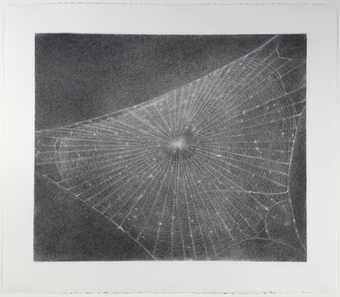
Vija Celmins
Web #1 (1999)
ARTIST ROOMS Tate and National Galleries of Scotland
Maybe I identify with the spider. I’m the kind of person who works on something forever and then works on the same image again the next day.
Vija Celmins
For Celmins, a work of art does not represent anything but itself. Even though she uses recognisable images of things, it is important to her that the viewer focuses on the artwork itself. She relentlessly examines the source images she works from, reworking them again and again, and exploring different or representing them through subtle variations.
The subjects she generally chooses – oceans, night skies and deserts – are all aspects of nature that seem limitless and suggest the infinite. Yet she often uses a detail of a photograph. She also controls the endless vistas of her subjects by placing her images on a support (a board or frame). This is important to Celmins because 'the images tend to run on and on, they have to be carefully ended.' In her printmaking Celmins began to increase the area of white paper around the print so the image itself became more concentrated: ‘My feeling about the size of the borders has a corresponding effect on how one perceives the image'.

Vija Celmins
Alliance (1983)
ARTIST ROOMS Tate and National Galleries of Scotland
In works such as Untitled (Galaxy-Desert) 1974 and Alliance 1983 Celmins paired images together. This is another way of exploring three-dimensional space and scale. By pairing the night sky with an engineer's drawing of a ship or a view of desert floor, she creates a dialogue between two different approaches to perspective – or treatment of space – on the flat surface of a piece of paper.
Celmins’s artworks based on photographs of spider webs also offer a different sense of perspective to the night skies and deserts. The spider webs are viewed at the same angle and scale as they might be in nature. The web – like the night sky and desert floor – acts as a kind of map, as it describes the picture surface. When we see these works together our attention is drawn to proportion and scale as well as perspective.
Like the desert, lunar surfaces and galaxies Celmins has explored the spider’s web repeatedly. The writer and curator Elita Ansone suggests that the spider’s web motif is related to the night skies images, commenting that 'each [spider's web] work represents a different feeling and a different image, as if each were a new galaxy.'
What do you think? Nature in art
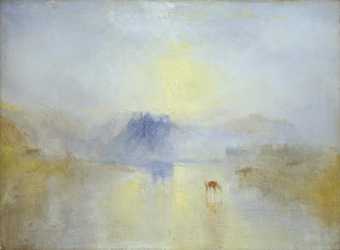
Joseph Mallord William Turner
Norham Castle, Sunrise (c.1845)
Tate
Nature as a theme dominates Vija Celmins's work. Explore how other artists have depicted the natural world by browsing nature-themed works in Art & Artists.
- Choose another artist who works from nature.
- How does their work differ from the subjects Celmins choses and the processes shes uses?
Have a go: Create a relief print

Vija Celmins
Ocean Surface Woodcut 1992 (1992)
ARTIST ROOMS Tate and National Galleries of Scotland
Ocean Surface Woodcut 1992 is a relief print. Relief printing involves incising a drawing into a surface such as wood. The incisions and any areas of the surface that are cut out do not hold the ink and appear white in the finished print.
Have a go at creating your own relief print. You could use lino or polystyrene instead of wood. Draw your image onto the lino or polystyrene. Remove the areas you want to appear white in your picture, then apply ink over your cut surface. Press a piece of paper to your inked surface to make your print.
Top tip: Use a rolling pin to press the paper onto the inked surface to ensure maximum transfer of your image. The back of a spoon gently rubbed over the paper works well too!
Process and materials

Vija Celmins
Night Sky #19 (1998)
ARTIST ROOMS Tate and National Galleries of Scotland
As I was working with the pencil, I got into some of the qualities of the pencil itself. That’s how the galaxies developed.
Vija Celmins
During the course of her career Vija Celmins has created sculptures, paintings, drawings and prints. She focuses on a small range of subjects and she uses a monotone palette – grey, white and black. Her meticulous approach can be seen throughout her making process: in her selection of paper and material; her decisions about what scale to use; and her choice of source images.
To create her drawings, prints and paintings she selects and masks out a detailed area within a photograph. She then copies this using a range of grey shades to represent the different tones within the black-and-white photographs.
In 1968 Celmins started drawing in graphite. She later commented:
… when I started doing graphite I got really into it … I was obsessed. I pushed the limits of the pencil to hold the image and make for strong work.
She spent the next few years drawing intense single images before she started putting drawings together on a single sheet of paper. Untitled (Desert-Galaxy)1974 is an early example of these double images. It sees Celmins return to the recurring motifs of the desert landscape and the night sky.
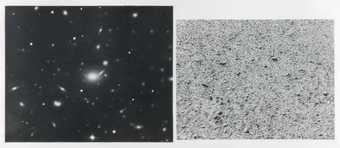
Vija Celmins
Untitled (Desert-Galaxy) (1974)
ARTIST ROOMS Tate and National Galleries of Scotland
In the 1990s Vija Celmins began making drawings of night skies using charcoal and an eraser. In drawings such as Night Sky #19 1999 she covers the surface of the paper using the charcoal and removes areas with the eraser, exposing areas of the paper. The white areas reveal the radiating strands of the web of stars in the night sky. She said 'I like to see the paper, because the paper is a player.'
Printmaking has also been an important part of Celmins's artistic output. She has worked with print media since the early 1960s, using various techniques: traditional intaglio, lithography and relief printing techniques such as woodcut. In the 1980s she created two significant series of prints Concentric Bearings, Alliance and Constellation Uncello.
What do you think? Materials and images

Vija Celmins
Untitled (Desert-Galaxy) (1974)
ARTIST ROOMS Tate and National Galleries of Scotland
Celmins has said that her galaxy paintings and drawings came about through using pencil. Look at drawings such as Untitled (Desert-Galaxy) 1974 and think about how a subject might develop by exploring what materials can do.
Can you think of any other artists whose output, or the images they make, is the result of exploring media and techniques?
Have a go: Experiment with charcoal

Vija Celmins
Night Sky #19 (1998)
ARTIST ROOMS Tate and National Galleries of Scotland
Make a reverse charcoal drawing
Use charcoal and an eraser to create a drawing, working in reverse to reveal the white of the paper. Cover the surface of the paper with charcoal and then 'draw' with the eraser, removing areas of the charcoal to reveal the white paper underneath.
Let charccoal do the talking!
Experiment with charcoal. Make a drawing using charcoal of a found image. (It can be any image, but it may help if the image is black-and-white). Explore the marks you can make with charcoal as you draw.
Charcoal can be used to make a range of marks. A charcoal stick, turned on its side makes a broad swooshing mark. Charcoal can also be used to create delicate and sensitive lines and marks. It can be smudged and rubbed away leaving only the faintest of traces.
Think about the distinct characteristics of charcoal and how these effect your finished drawing.
Memory

Vija Celmins House #2 1965
© Vija Celmins
There was a little period where I think, in some strange, intuitive way, I sort of dealt with the memories of war.
Vija Celmins
Although best known for her contemplative images of nature, the subjects of Celmins's early work were very different. War planes, smoking guns, automobile crashes and explosions feature in her paintings of the 1960s. These paintings were based on photographs she found in books about the Second World War.
Celmins’s work is not autobiographical – she generally does not make work about her experiences or feelings. But she has commented that many of these 1960s works relate to her early childhood memories of the Second World War. Thinking about these childhood memories, she said:
… it was a time of great stress, mostly because there was so much noise and chaos. And my biggest fear was being left somewhere and not finding my parents.
House #2 1965 is among Celmins’ earliest sculptures and also relates to her wartime childhood experiences in Latvia. Celmins painted fires and plane crashes on the outside of the dolls’ house. That Celmins’s father was a builder, makes her choice of subject particularly significant.
This violent imagery can also be seen in relation to the political backdrop in the 1960s, and the Vietnam War. Celmins was passionately anti-war and attended demonstrations against the USA's involvement in Vietnam. Discussing her early sculptural works and making specific reference to House #2 (one of her favourite pieces from the time) Celmins has said: 'I have to admit that there is a psychological component to the work.'
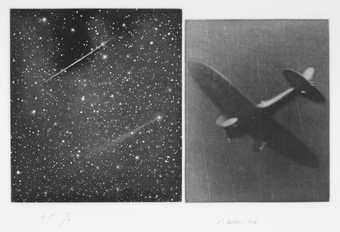
Vija Celmins
Concentric Bearings B (1984)
ARTIST ROOMS Tate and National Galleries of Scotland
The warplane also appears in the Concentric Bearings series. In Concentric Bearings B 1984 an image of a falling plane being shot at is placed next to Celmins’s image of stars shooting in the night sky.
Writer and critic Dave Hickey has suggested that Celmins’s shift from using imagery of war and violence, to the ocean, desert and sky, paralleled a shift in her personal life. Writing in the catalogue for her retrospective exhibition at the Institute of Contemporary Arts, Philadelphia; he says that her status changed ‘from the status of a refugee to a nomad – a nomad who could find her bearings from the infinitesimal reference points that nature offers.'
Time
Vija Celmins
The reason I think I do images that require so much time is that I feel the physical work itself lets some other thing that came through, letting something unconsciously seep through, some subtlety that my brain was not capable of figuring out …
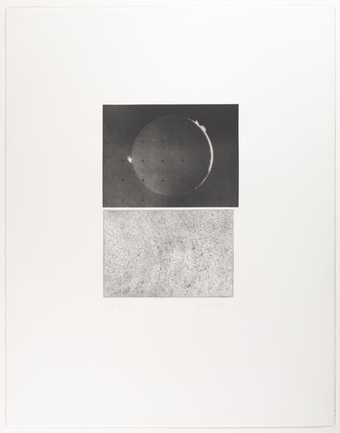
Vija Celmins
Jupiter Moon - Constellation (1983)
ARTIST ROOMS Tate and National Galleries of Scotland
Shooting stars, turning planets and rippling oceans suggest movement and the passing of time in Celmins's images. While there is this cosmic sense of time in the elemental subject matter she works from, the subjects also allow the artist to explore the relationship between deep space and the flat surface of a picture.
Influenced by minimalist artist Ad Reinhardt’s Twelve Rules for a New Academy 1953, Celmins started to consciously strip away elements in her art. She rejected the use of expressive gestural marks and planning compositions. The vast expanses of ocean views, deserts and star fields she depicts have no beginning or end. This also gets rid of the need to compose or arrange elements within a picture. She creates depth through her intense investigation of the image and her chosen material. Most of her images, like Web #1 1999, are painted or drawn very close to the edge of the surface she is working on and seem to extend beyond the canvas, or edges of the paper, into the space occupied by the viewer.
As the artist describes it, although the image is ‘pinned down, in your mind it wants to expand out. Reality (the art) makes it stay where it is on the wall'.
Made, invented – it is not the image experienced in life, but in another reality.
Her painstaking approach and the intuitive nature of her process restricts how much work she makes and in turn limits displays of her work. She works methodically at her own pace and has likened herself to the spider and its precise and industrious constructions.
What do you think? Time, photography and process
The image stays where it has been placed so rigorously and attentively. The original photographic source is from another space we have lived in but is transferred by the making into another space.
Vija Celmins
The thing I like about painting is that it takes just a second for the information to go in and you can explore and analyse that later.
Vija Celmins
Celmins works from found photographs. A photograph can be created in less than a second. Replicating those photographs in her meticulous drawings, paintings and prints, can take Celmins many days.
Do you think this sense of time comes across when you look at her work?

